若手研究者発表資料
12.17 (Tue)2019

若手研究者の発表資料
山極壽一総長と若手研究者による座談会
「未来を担う若手研究者と地球社会の持続可能な発展に向けた対話」
若手研究者へFacebookで「いいね!」応援よろしくお願いします!
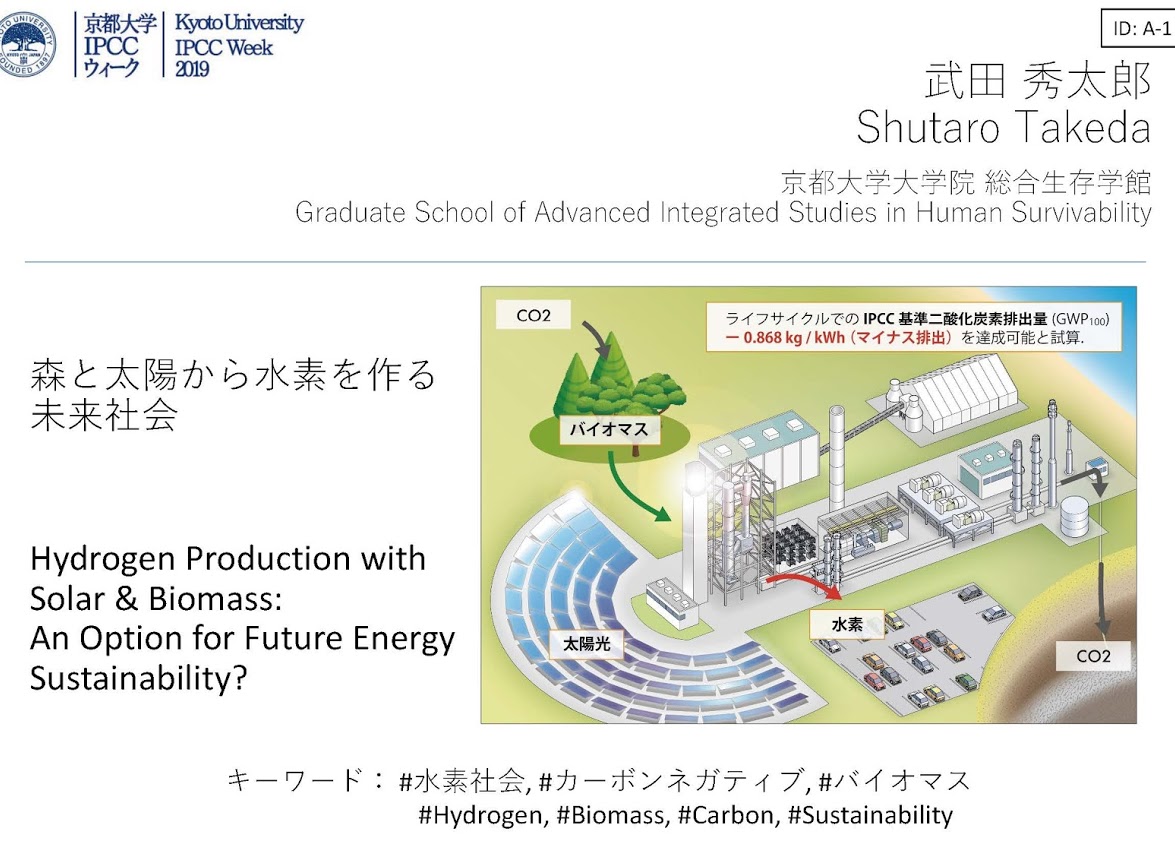
武田 秀太郎 特任助教 (Dr. Shutaro Takeda)
京都大学大学院 総合生存学館
本日私が提案をしたいのは、「森と太陽から水素を作る」という未来社会である。
森こそ、人類の文明の根源である。50万年前にホモ・エレクトスが火を発見して以来、この森というバイオマス資源の燃焼によるエネルギー利用こそが、ヒトという種の社会文明の発展を支えてきたと言えよう。しかしながら、以来50万年もの間、人類は森の利用方法を根本的に変えて来なかった。しかし、それで良いのだろうか?
もし太陽光の熱により森から得られたバイオマス資源をガス化、水素を生成すると共に二酸化炭素を回収するプラントが実現されれば、生命の源であり炭素吸収源である自然との共生を通じ、持続可能な都市文明の構築が可能となるのではないだろうか。森と太陽から、水素を作る。私の試算では、本プラントでエネルギーを生成するならば、ライフサイクルでのIPCC基準二酸化炭素排出量として- 0.868kg / kWhのマイナス排出を達成可能である。私はこれこそ、21世紀の人類文明に相応しい新たな森の利用方法であると提案したい。
無論、この技術的提案は、今後無数に必要となる脱炭素化へ向けた無数の技術革新の1つに過ぎないであろう。本IPCCウィークにおける座談会における議論を通じ、パリ協定へ向けた人類の道筋を見出す努力を継続したいと考える。
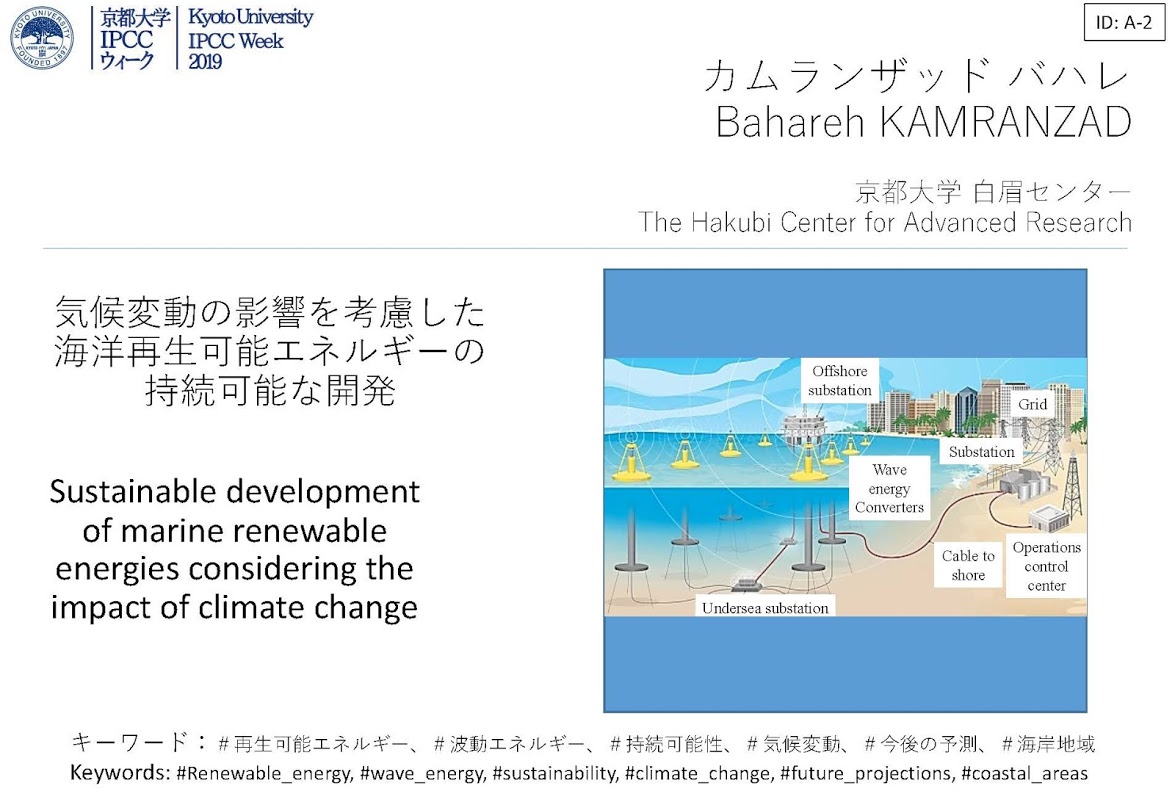
カムランザット バハレ 助教 (Dr. Bahareh Kamranzad)
京都大学 白眉センター
Fossil fuels have caused:
- Green-house gas emission
- Decreasing the reserves of carbon fuels
- Geopolitics wrangling over the control of oil and gas reserves è many conflict and all-out wars in last decades in areas with vast resources like middle-east
Solution: Development of renewable energies!
71% of the Earth’s surface is covered by water and oceans hold more than 96% of all Earth’s water. 2/3 of the all population lives within 100 km of a coastline!
Marine Renewable Energies can be a good solution to provide part of the energy demand!
However, these resources are affected by change of climate! So, it is important to investigate the impact of climate change for a future sustainable development!
In July 2018, government of Japan approved a new basic energy plan committed to increase the role of renewable energy resources from 15% (in 2016) to 22-24% (in 2030). But still, 56% will be provided by fossil fuels! (and 20-22% from nuclear)
Of course there is no single solution to our energy and climate challenges, but Japan with its unique geographical location and being exposed to vast marine renewable energies can benefit the green and clean available resources by the ocean for a future sustainable development.
More than 70% of the energy supply investment in the world is government-driven (30% is market- driven) è our energy destiny rests with governments.
So, our mission is to perform research on the available resources, reducing the uncertainties, and disseminate the result especially for government-related sectors and decision-makers to inform them about the available and potential green and clean sources of energy and their benefits for a future sustainable development.
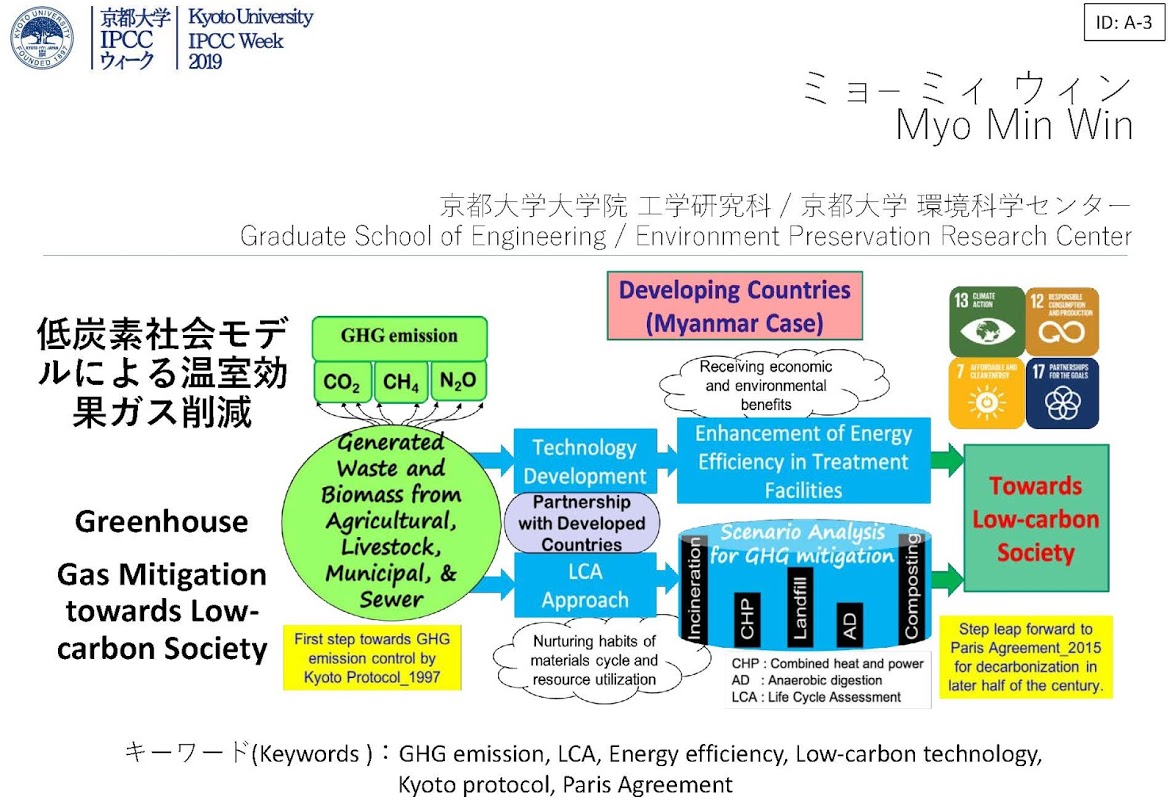
ミョー ミィ ウィン 博士課程学生 (Mr. Myo Min Win)
京都大学大学院工学研究科 環境科学センター
Good evening to everyone attending in this President`s roundtable meeting!
I am Myo Min Win from Graduate School of Engineering, Kyoto University. I do research works at Environment Preservation Research Center over four years. I come from Myanmar to study Japanese Education System and Techology Development.
Today, I`d like to unfold about my research activities in making efforts to reduce GHG emissions from generated waste and biomasses and how we will strive for low-carbon technology and approach in developing countries, today, in the case of Myanmar as an example.
Among the several sectors, for example, energy, transport, forestry, waste, etc,. which emits GHGs in Myanmar, I will only focus on Waste Management sector.
In this regards, there are several sources which generates waste and biomasses such as from agriculture, livestock, municipal, and sewer. These all will be considerd in this study scope because it emits significant amount of GHGs due to traditional practice, open burning and unsanitary disposal behaviors.
At the same time, we will make use of these resources effectively by generating the power such as electricity from these waste and biomass resources.
There are two pathways we approach.
1) First is management of generated waste by conducting LCA approach. It means we will set different waste management scenarios for generated waste and biomasses applying different waste treatment technologies as can be seen Incineration, CHP, Landfill, AD and Composting.
From this scenario analysis and comparison, we could propose appropriate options to mitigate GHG emissions.
2) The second pathway is focusing on specific technology development by alternative countermeasures on GHGs emission control by enhancing energy efficiency.
In this way we can not only consider GHG emission mitigation but also generating the power and electricity from the generated waste and biomasses.
From these research activities experiences in Kyoto University, Japan, I wish I could share knowledge and contribute my experiences for my homeland, Myanmar`s vision on marching towards low-carbon society.
Thank you very much for your kind attention.
ありがとございました!
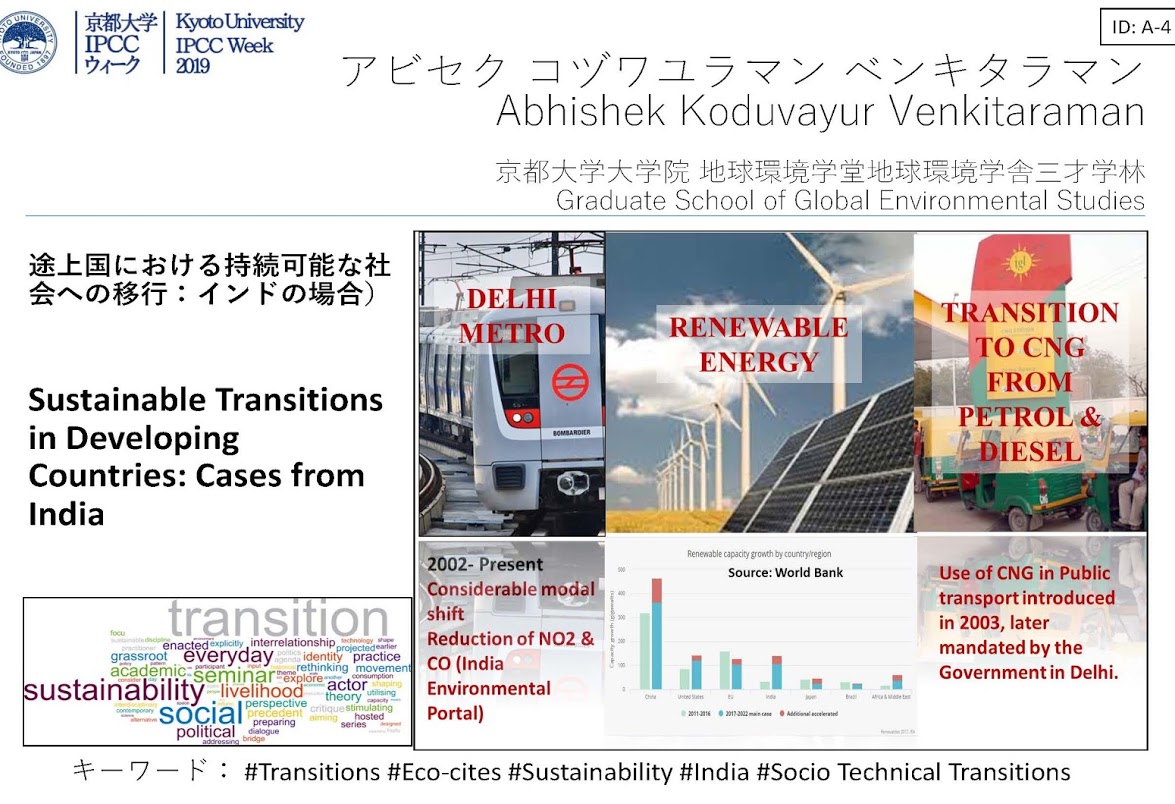
アピセク コヅワユラマン ベンキタラマン 博士課程学生 (Mr. Abhishek Koduvayur Venkitaraman)
京都大学大学院地球環境学堂
Good afternoon everyone, my name is Abhishek, and I am from India, I am a Doctoral student presently in Kyoto University and I am studying about Sustainable transitions in developing countries.
Sustainability transitions are long-term, multi-dimensional, and fundamental transformation processes through which established socio-technical systems shift to more sustainable modes of production and consumption. But, when it comes to developing countries, there can be a number of barriers to sustainable transitions. Government plays a central role which help in fostering aregime shift, but there are majorinstitutional and politicalaspects which form barriers to transition and upscaling. This is where, the question of good environmental governance comes into forefront. Regimes in developing countries like India show a much higher degree of frequent changes, non-uniformity and internal tensions. Often, an institutional reform is the best solution to such barriers. This can help accele rate sustainability transitions.
Here, I would like to present three cases of such sustainable transitions in the case of India’s capital city: Delhi. The first one is the case of Delhi Metro rail. A rapid transit network that opened its first corridorin 2002 and today, the network consists of 8 regularroutes, running 343 kilometres,serving 250 stations. As per the Environmental Portal of India, Delhi metro has had a considerable positive impact on the Air Pollution of the region, resulting in reduced emissions and a considerable shift from private to public transport among residents.
The second case is the production of renewable energy. India is one of the countries with the largest production of energy from renewable sources. As per a report by World Bank, India ranks number 4 in renewable capacity growth. At present, Delhi Metro Rail Corporation uses solarenergy foralmost 60% of its electricity needs. It plans to run all its operations on solarby 2021 as pera recent initiative.
The third is the shift from petrol and diesel to Compressed Natural Gas (CNG) in all public transport in Delhi. The breakthrough in this transition was in 2003 when the Delhi Government mandated the use of CNG in all means of publictransport.
It’s also worth mentioning the case of Kyoto city which is utilizing biodiesel since 1997 in some public buses. It contributes in reduction of Carbon Dioxide by 2600 tons per year. I believe that developing countries can learn more from the above mentioned cases forpaving way forfuture sustainability.
So, sustainable transitions indeed, take a long time in developing countries like India. I believe, that as a citizen of a developing nation, and privileged to be skilled, the time is appropriate for me to align with the global efforts in action research in achieving sustainable development, and the IPCC President’s round table has offered me a platform to express my opinions to a broader range of people.

私は研究テーマとして、世界規模での水循環の解析を行っています。
この解析を通して、世界にどれくらい利用可能な水があるのか、あるいはどこで足りなくなるのか、ということが解析できます。
過去の世界の水不足の度合いの解析を行ったところ、中国やインド、アメリカの穀倉地帯で水不足になっていたことが分かりました。これらの地域では足りない分を地下水から過剰に取水することで賄っているのです。一度過剰に地下水を取水すると地盤沈下が起こり、二度と元には戻りません。その結果、1年に1m以上も地盤沈下したという報告もされています。
この現状の中で、将来はどうなるのかというと、より深刻になると予測されています。現在の世界の人口はちょうど77億人なのが、2050年には98億人に、つまりたった30年で人口が20億人も増えるのです。歴史的にみると、これまで世界の水使用量は人口の2倍のペースで増えてきました。つまり人口が2倍になったとき、水使用量はその4倍にもなったということです。もし仮に同じペースで水使用量が増えれば、恐ろしいことになりそうです。ただ日本には水はたくさんあるので関係ないと、皆さんは思われているかもしれませんが、他人ごとではありません。日本の食料自給率は約40パーセントなのに、食料が輸入できなるかもしれないからです。食料の生産には水が大量に必要で、飲み水などの生活用水は取水量全体の1割程度しかない一方で、農業用水は約7割にも上ります。またトウモロコシ1kgを生産するのに1.8トンの水が必要で、さらにそれを餌とする牛肉は、1kg生産するのにその20000倍もの水が必要になるのです。人口が増えて水の需要が増える一方で、水不足の中国・インド・アメリカの穀倉地帯では、取水源の地下水は減る一方です。さらにこの3か国で世界の穀物生産量の3分の1を占めているので、地下水の枯渇は世界にとって致命的な問題と言えるかもしれません。
こういった危機的な状況を踏まえて、私は現在写真にあるような田んぼとサトウキビ畑にセンサーを置いて井戸の地下水や気象データ等を観測して、水の循環を詳細にモニタリングしています。このデータを活用して、雨の影響や取水、地下水などの関わり合いを統合的に診断できるツールの開発を行っています。
この研究を通して、複雑な水循環システムを明らかにすることで、将来の深刻な水不足への対策に少しでも貢献したいという思いで、これからも研究を行っていきます。
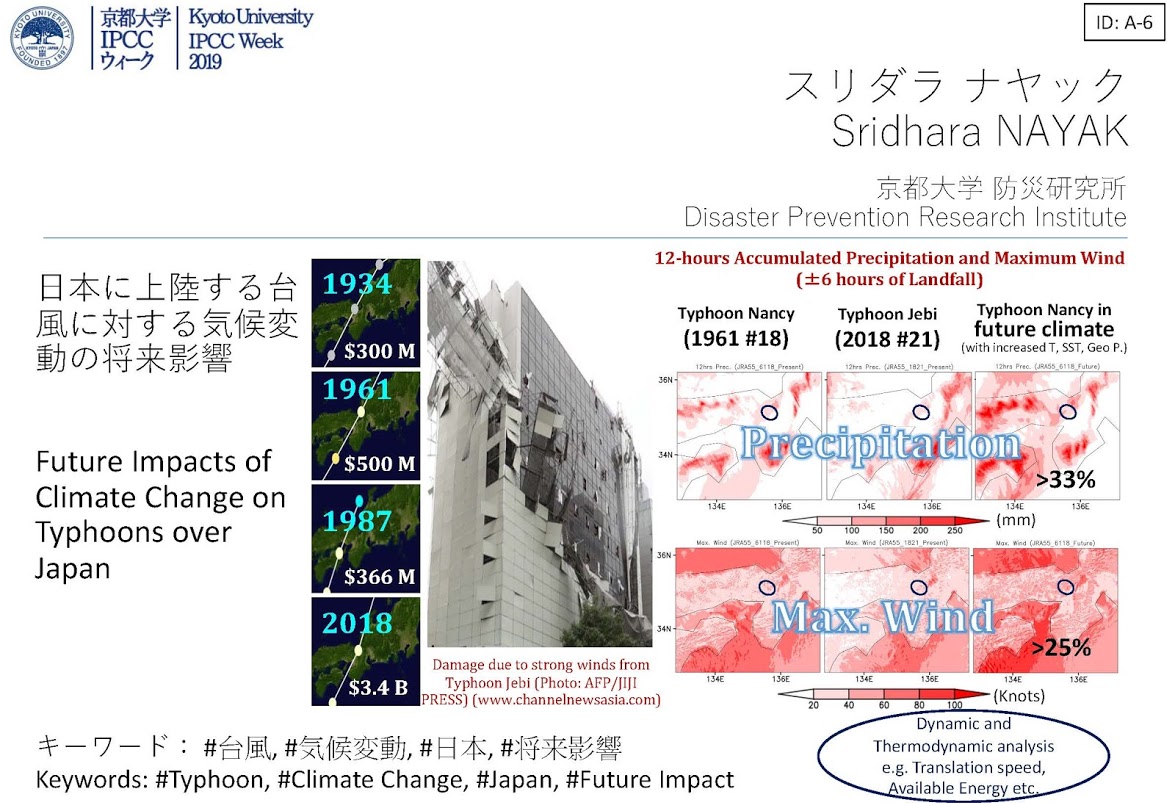
スリダラ ナヤック 特定研究員 (Dr. Sridhara Nayak)
京都大学 防災研究所
I will discuss the dangerous typhoon Jebi (#21) that made landfall last year over western Japan and caused a lot of damages (about USD 3.4 B).
This typhoon brought life-threatening high winds and heavy rainfalls to the landfall areas.
Our researches find that this typhoon is a possible climate change impact of some previous typhoon that made landfall in past years over same region.
Our research highlights that similar typhoons may occur in future warming climate which will be more stronger and a severer threat to human life and properties.
Adaptation
We need to build potentially more resilient societies to face the typhoon related disasters
Helping people to actively participate in the disaster risk reduction activities
Making policies to improve the household resilience to dangerous events
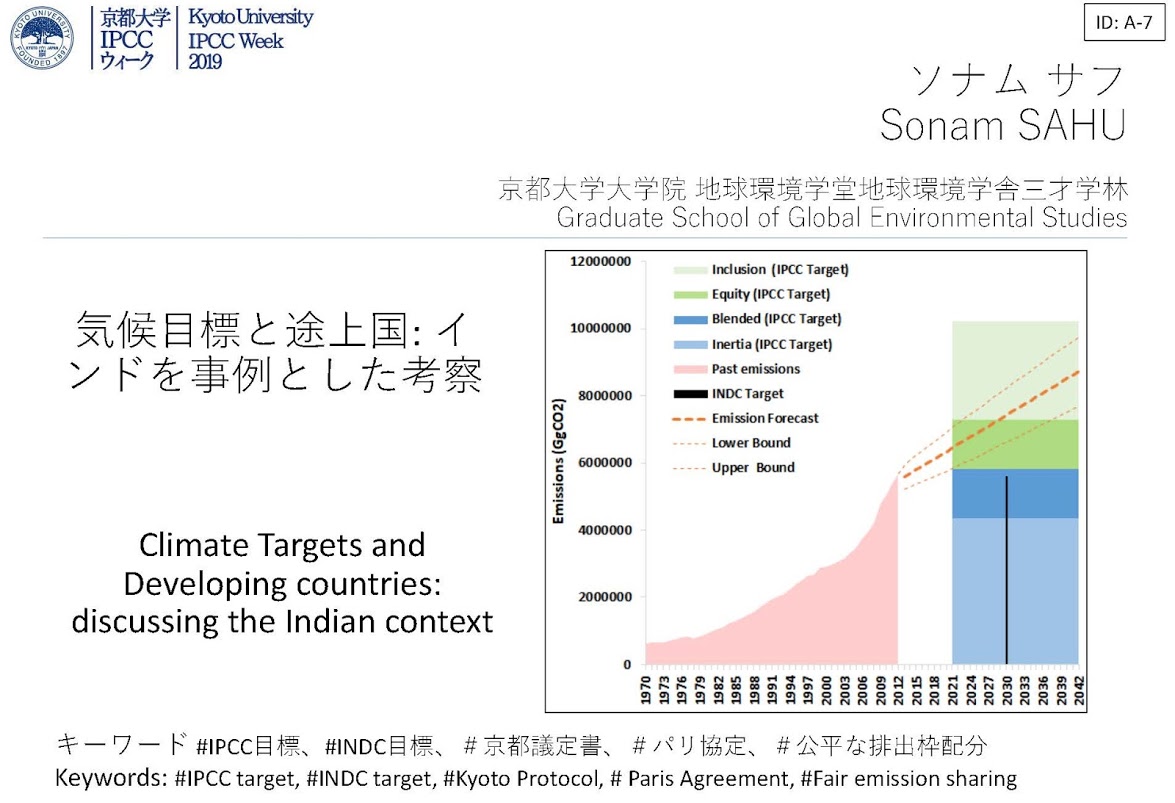
ソナム サフ 博士課程学生 (Ms Sonam Sahu)
京都大学大学院 地球環境学堂
Good afternoon everyone. This is Sonam Sahu from India.
My research talks about India’s national and global climate targets. In this research, it was estimated that how much reduction is required by India to meet the climate targets.
India’s national climate target is defined in India’s Intended Nationally Determined Contribution (INDC) while global target is defined by the Paris Agreement. According to the national target, India aims a 33 to 35% reduction in GHG intensity of GDP of 2005 levels by the year 2030. According to studies, India’s economy is expected to grow at 7% between 2005 and 2030. With this growth, India’s emissions in 2030 are projected be 5.6 x M Gg (see INDC target in the figure).
The IPCC targets are more complex to translate. For limiting the temperature rise to 2 degrees, there is a limited emission budget that the world can emit. This emission budget is to be strategically distributed among countries. Scientists have discovered many sharing principles for an honest distribution of emissions. In this research, four sharing principles were employed. First was the inertia principle which is based on the past emissions of countries. Second was the equity principle which is based on the population of the countries. Third was the blended principle which is a balance of inertia and equity. Fourth was the Inclusion principle which includes the factor of historical accountability of countries. According to these four principles, India’s future emission budget was determined (see IPCC targets in the figure).
The orange dotted lines in the figure show the emission forecast of India as per the Business As Usual scenario. It can be observed that currently India’s emissions are forecasted to be higher than the INDC target as well as inertia, equity and inclusion sharing allocations. It was found that as per current emission trajectory, a 24% reduction in the year 2030 was required to meet the INDC target. While, a 42.5% reduction in cumulative emissions was required to meet the global target if inertia sharing is followed, 23% if blended sharing is followed and 3% if equity sharing is followed.
Analysis of these outcomes reveal much about India’s future budget accounts.
Firstly, it can be observed that in the emission distribution science, the high population count and factor of historical accountability favour India the most.
Second observation was that the reduction required by blended principle is very close to INDC target. This states that among the Paris Agreement targets, blended principle is the best match for fulfilling India’s need of economic development as well as the World’s need of governing climate change.
These statistics are important for the World as they define the exact target for the countries and hence support global climate change management efforts and mitigation actions.
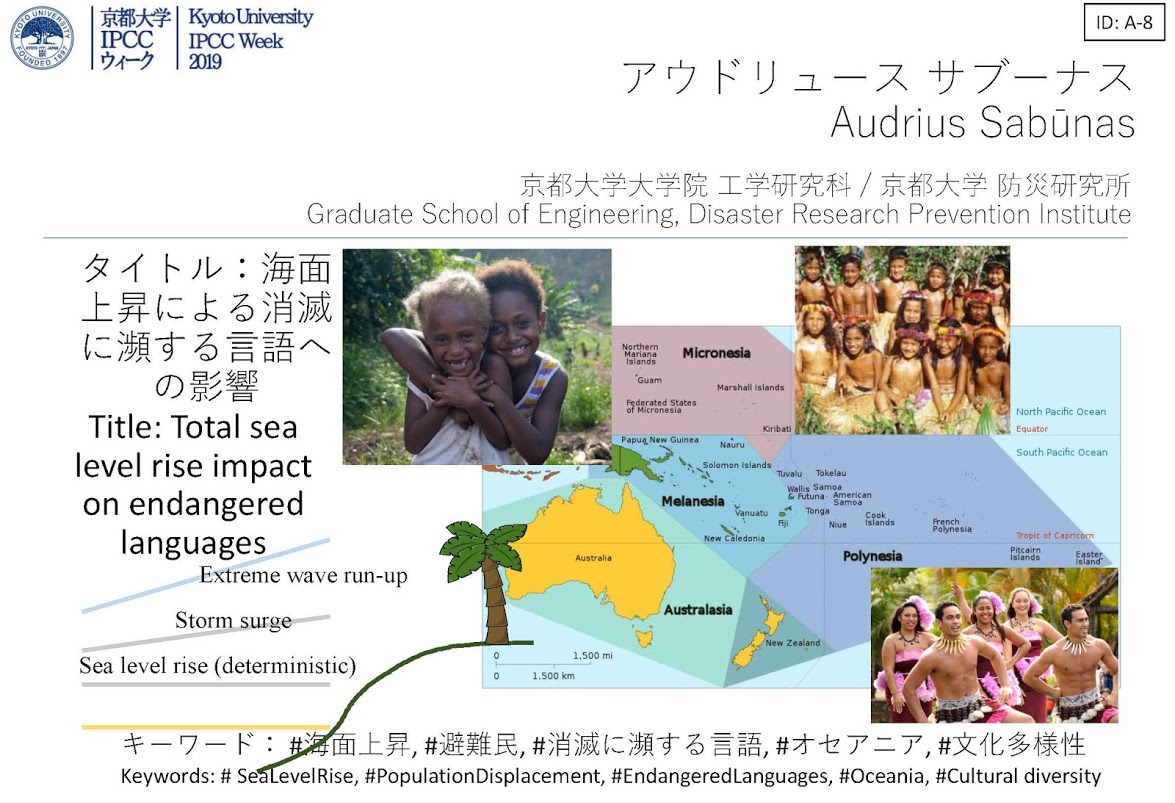
アウドリュース サブーナス 博士課程学生 (Mr. Audrius Sabunas)
京都大学大学院工学研究科/ 防災研究所
My name is Audrius Sabunas and I am a 1st year PhD student from Coastal Engineering Laboratory at Kyoto University.
Today I would like to present an overlooked issue – the link between sea level rise and the extinction of languages in the South Pacific Region.
I am certain this issue is relevant for Intergovernmental Panel on Climate Change (IPCC). Even though many studies exist about the way climate change makes negative impact on economics and biodiversity, there is a lack of study on its impact on cultural diversity and endangered languages. In this way, it helps understanding the interdisciplinary nature of climate change. Furthermore, the diverse South Pacific Region is understudied, even though it is perhaps the most vulnerable to the rising sea levels.
I am using here the term total sea level rise, which includes not only determinist sea level rise which happens mostly due to thermal expansion of water molecules, but can be refered to as the cumulative effect of storm surge, extreme wave run-up and the deterministic sea level rise.
I am focussing on Oceania, which is comprised of Micronesia, Melanesia and Polynesia. A significant proportion of islands in the South Pacific are susceptible to rising sea levels due to low-lying coastal areas, especially coral atolls. Oceania is known for its cultural diversity and is home to 6 million people and at least 90 endangered languages.
You may ask what the link between climate change and language extinction is. The logic works this way: as coastal areas get inundated and that happens more frequently due to climate change, islands get more and more submerged and that gravely affects the economy, forcing the displacement of the local population. This in turn threatens local cultures and languages.
My research is still going, but according to my founding, even Fiji, one of the biggest Oceanian countries and not one of the most vulnerable ones in the South Pacific will have forced relocations, as most low-lying coasts also have a high population density and are places where main businesses are situated. As the time lapses, the number of the displaced people in Fiji is only going to increase.
In addition to that, it is likely that total sea level rise will have a devastating impact on all Micronesian sub-region languages, as well as many other Oceanian island countries. I estimate that the climate change will speed up the disappearance of approximately 40 languages.
I am sure each language and culture is like a hidden gem with its distinct world that impoverish our human civilization once lost. Let us all conspire to leave the Earth in as good shape as we can for the future generations! The power and responsibility is ours.
Thank you for your attention!
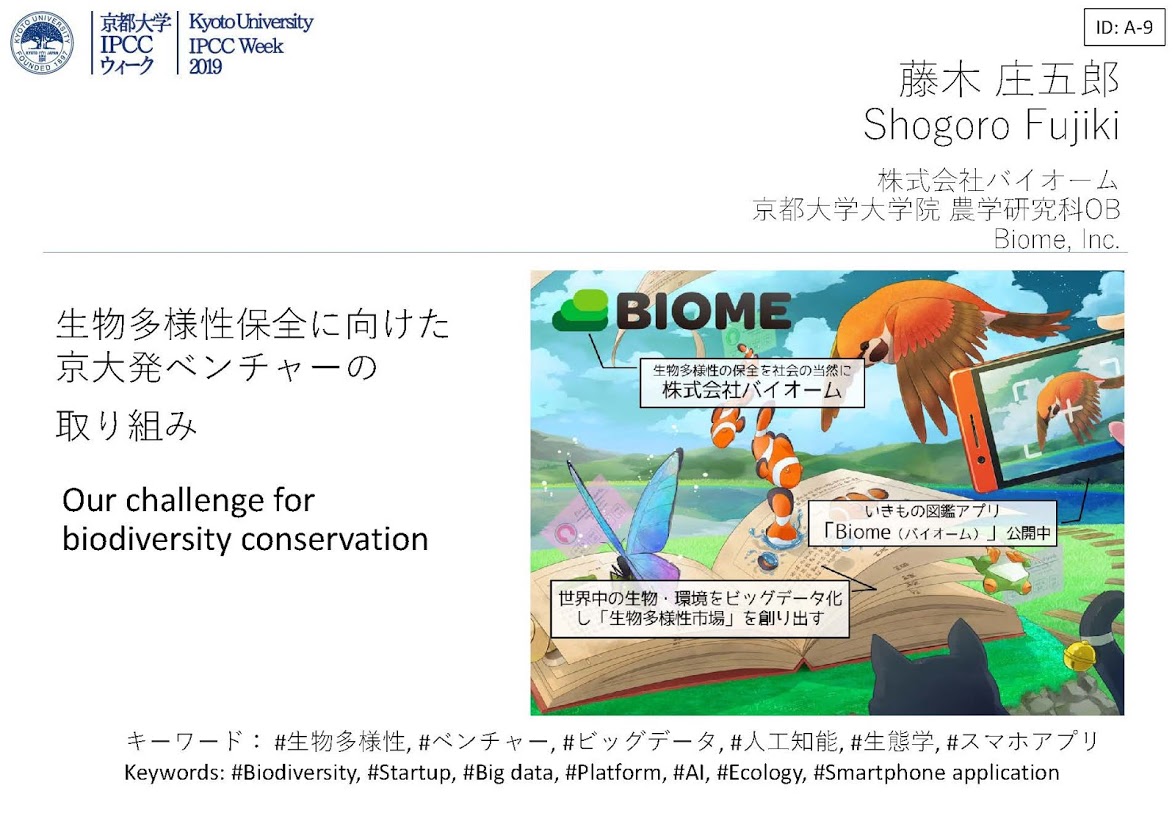
藤木 庄五郎 代表取締役 (Dr. Shogoro Fujiki, CEO) 株式会社バイオーム
1.自己紹介
・京都大学農学研究科で生態学を専攻
・環境問題、特に生物多様性の減少について興味がある
・衛星画像を用いた生物多様性定量化技術の開発に従事
・2017年から株式会社バイオームの代表取締役
2.取り組みの紹介
・生物多様性の保全をビジネスとして成り立たせるという難題に挑戦 ・世界中の生物分布情報をビッグデータ化する
・ビジネスサイドが生物多様性保全を実行できるためのインフラを構築する
・現在はスマートフォンアプリ「バイオーム」を開発
・楽しみながらゲーム感覚でいきものに触れ合うことができるポケモンGOのリアル版のようなアプリ
3.メッセージ
「環境保全」というのが、崇高でキレイごとになりすぎているのではないか
環境問題の本質は、欲とかお金とか、そういう人間臭い、ある意味汚い部分にあるのではないか。そこに環境保全のパラダイムをぶつけていかないと保全は前には進めないのではないか。環境を保全することがお金になる社会を作らない限り、人類に未来はない。だからこそこれからの環境保全は、民間企業が主体になっていかないといけない。
環境保全を主導しておこなっているみなさんは、いま取り組まれているプロジェクトが失敗に終わったとき、何を背負いますか。リスクを背負っていますか。僕は自分と従業員8名の人生を背負って取り組んでいます。環境保全をベンチャー企業として取り組むというのは、そういう覚悟とリスクをともなうものだと思っています。今、人類が背負っているリスクと比べればあまりにも小さいリスクだと思います。ここに集まった、保全を主導しておこなっている人たちはもっとなりふり構わず、がむしゃらに、そして一致団結して取り組んでいきませんか。まずは、今日ここに集まった人たちで、一緒に協力して、時代のメインストリームをつくっていきませんか。
僕から伝えたいことは以上です。
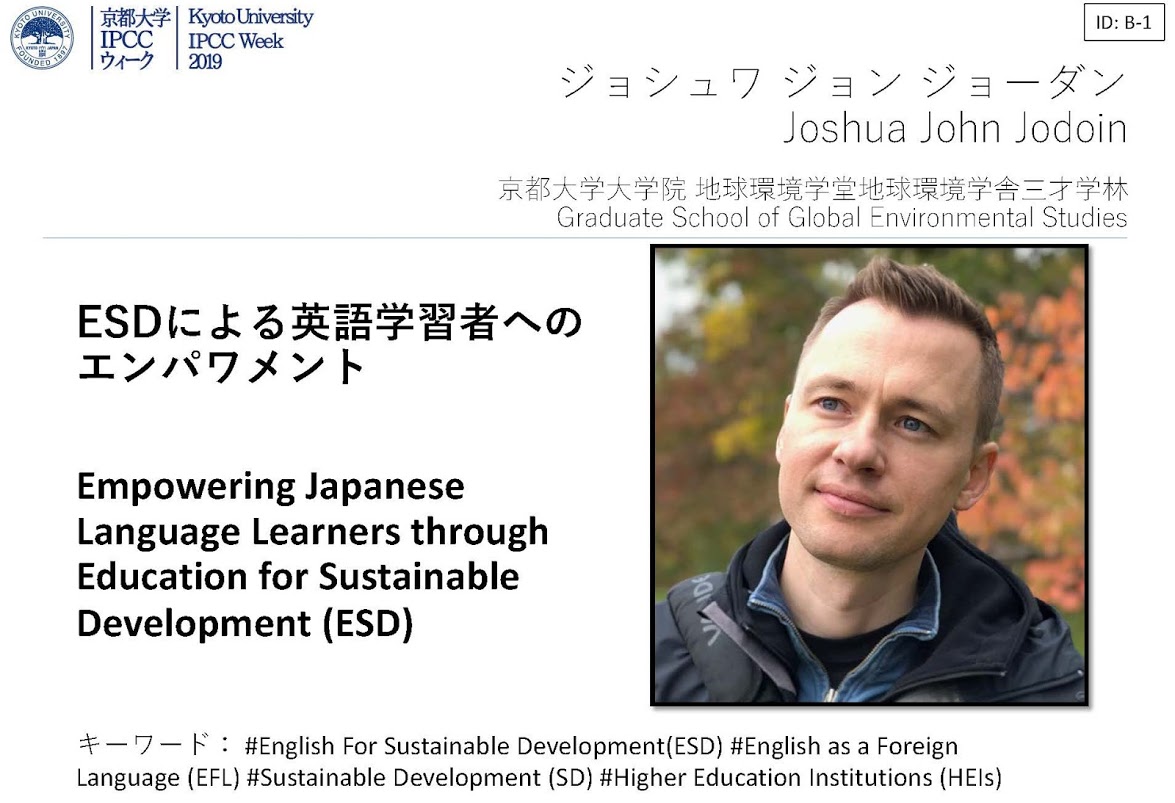
ジョシュワ ジョン ジョーダン 博士課程学生 (Mr. Joshua John Jodoin)
京都大学大学院地球環境学堂
Ladies and gentlemen of the public, members of the IPCC, President of Kyoto University, and fellow graduate students,
My name is Joshua John Jodoin and I wear many hats. Today, I represent a 3rd year graduate student in the Graduate School of Global Environmental Studies at Kyoto University, who is passionate about how to empower Japanese university students with environmental values, beliefs, and norms as well as offer them the language skills to take their understandings beyond Japan and talk to the world. Yesterday, I was a teacher discussing the importance of the Sustainable Development Goals, the SDGs, with my students, who will inherent the responsibility to find solutions to these problems. And, lastly, I have always been a human being living amongst 7.6 billion other fellow humans. Humans that all desire education and a slice of the comforts that oil and gas have ushered in through industrialization over the past 100 years. Our relative comfort, living in the developed world, has come at a price on our environment and I feel an obligation to work towards mitigating our large footprint because 7.6 billion people are relying on our efforts. I wish to share two simple ideas with you today:
First off, if you want to make an impact on climate change or you are concerned about the next generation (your grandchildren, your students, your community), then start a conversation. Right now, we are dogged by complacency about the problem and a push back from those that would rather not understand the truth. Dialogue with others, in all walks of life, is what is going to build the momentum to finding the solutions we need to climate change. Be sure to talk to everyone, especially your community leaders and politicians, about climate change and put this issue on the agenda. Because it is then, when enough pressure builds, that we see effective policy and societal transformations. As an educator, I see it as my duty to have these discussions with students and colleagues as well as promote more disciplines in higher education to build climate change into their curriculum, what we in ESD call mainstreaming. Every discipline from anthropology to engineering can help to find the solutions on how to mitigate the worst aspects of climate change. So, talk to people, talk to everyone, and talk about it until you see the necessary changes in your community.
Secondly, on the point of dialogue, Japan has so much to offer the rest of the world. You have incredible research institutions, sophisticated technologies, and cultural insights into nature that many in the world could benefit from. Japan, as a country, also spends considerable effort, money, and resources to teach our students other languages, namely English, in order for them to participate in the globalizing world. This is tremendously important because the solutions to climate change cannot happen in isolation; We must engage as a global society in order to find these solutions. For these reasons, I believe that we need to do a better job of language and cultural education in Japan so that our students, and future leaders, can not only share Japan’s rich cultural and technological understandings with the world but also bring insights back from the rich tapestry of knowledge in other places. Language and cultural education are ways to bridge the divide in a globalizing world and find the solutions to enormous problems, like climate change.
To close, I don’t have to remind you of what is at stake if we do nothing about the existential threat of climate change. It is terrible to think that the next generation, your grandsons and granddaughters, will live in a world that is worse off than this generation. We, here in Japan, live in one of the most developed countries in the world, which can be a well-spring of innovation and problem-solving… but only if we communicate effectively and engage in dialogue with others. That is why I am so grateful to the organizers of today’s event because it is events like these that get this important dialogue started.
Thank you.
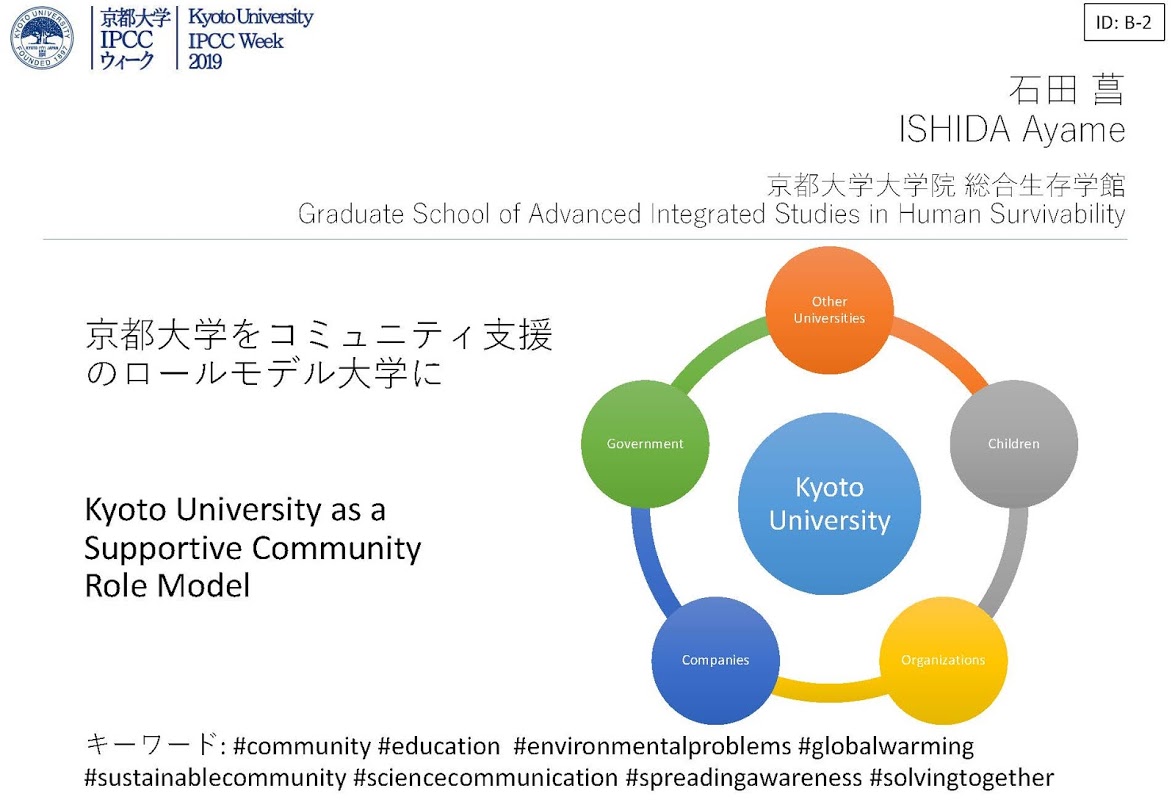
石田 菖 博士課程学生 (Ms Ayame Ishida)
京都大学大学院総合生存学館
While many researchers from Kyoto University have received noble prizes and other honorable statuses, I believe that Kyoto University can do better in making positive action in social problems. As a leading University, Kyoto University has a responsibility to be the role model for other Universities. I believe that the universities and other educational institutions can take a bigger role in making postive actions. For example, there could be more events on campus to be aware of wastes that Kyoto University community produces. Constant reminder could lead to engraving the value to the community members. Additionally, the university could show more support to community services. Students can have required hours to do community services for credits. More involvement in the community such as local schools, elderly homes, nature conservation, etc. could help Kyoto University community members to be more involved in the bigger community. This kind of activities could help Kyoto !
University community members to think in a bigger scale as well. The values gained from these experiences could help researchers as well. Researchers could be more aware of the demands and problems in the society that need to be researched or solved.
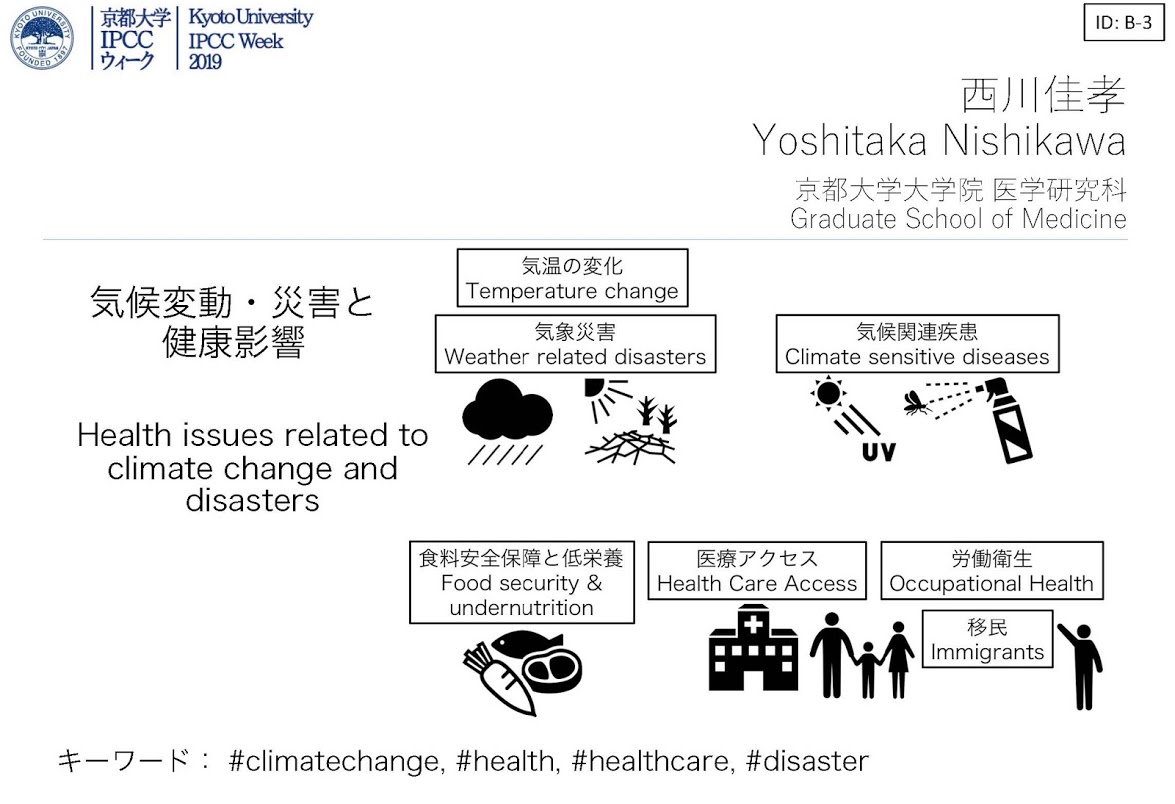
西川 佳孝 博士課程学生 (Mr Yoshitaka Nishikawa)
京都大学大学院 医学研究科
去年の京都の夏は暑かったでしょうか?暑かったですね。
実際、猛暑日は歴代2位の32日ありました。夏には、熱中症が心配です。気候変動を考えるときには、健康についても考えねばなりません。
私は内科医で、京都と、縁あって福島県で診療しています。また、公衆衛生学と呼ばれる分野のひとつの、健康情報学、という研究室で大学院生として活動しています。
global society (地球社会)の持続的発展についてですが、社会にはもともと、人の共同体、という意味があります。公衆衛生学は、健康と社会について考える学問です。
今日は、気候変動と健康について、直接的なものと間接的なものにわけてみます。
まずは、気象の変化による直接的な影響。これには、気温の上昇、嵐、干ばつ、熱波などが挙げられます。また、異常気象の増加が報告されており、大雪が増えるかもしれません。暑ければ、脱水症を起こしますし、雨や雪などは、直接、怪我にもつながります。干ばつや津波といった、天候関連の災害に繋がる恐れもあります。これらに伴って、身体だけでなく精神的な影響も予想されます。
次に、間接的な影響。気温が上昇すると、熱帯地域特有の疾患が広がります。2014年には、国内でデング熱の感染者がありました。蚊や蝿といった昆虫によって媒介される感染症には注意が必要です。このほか、紫外線がリスクとなる疾患もあります。例えば、皮膚がんの一種である悪性黒色腫。また、作物が不作になれば、低栄養のリスクがあります。
また、先に述べたような、天候関連の災害が起こると、間接的な影響も起きます。避難は、高齢者の死亡リスクです。また、避難は、家族や地域社会を分断し、社会的孤立を生みます。
例えば、2014年2月には、日本でも記録的な豪雪がありました。山間部で、大雪で道路が寸断されてしまった事例を紹介します。私が通う福島県の被災地では、まだ避難の影響で、医療機関が閉鎖しているため、血液透析患者さんは、山を越えて、1時間ほどかけて医療機関に通います。透析患者さんは、週に2–3回の通院を行って、透析を受けます。これが生命線です。この症例は、地域の方の協力で、救急車を利用して、4時間かけて到着する事ができました。天候の影響は、医療へのアクセスにも及びます。
気候変動により、地方で求人が減ると言われます。失業は、健康リスクです。また、移民の方が増えると、この方達の健康もまた、公衆衛生上の課題です。
このような時代において、人と地球は持続可能な付き合い方を考えなければなりません。
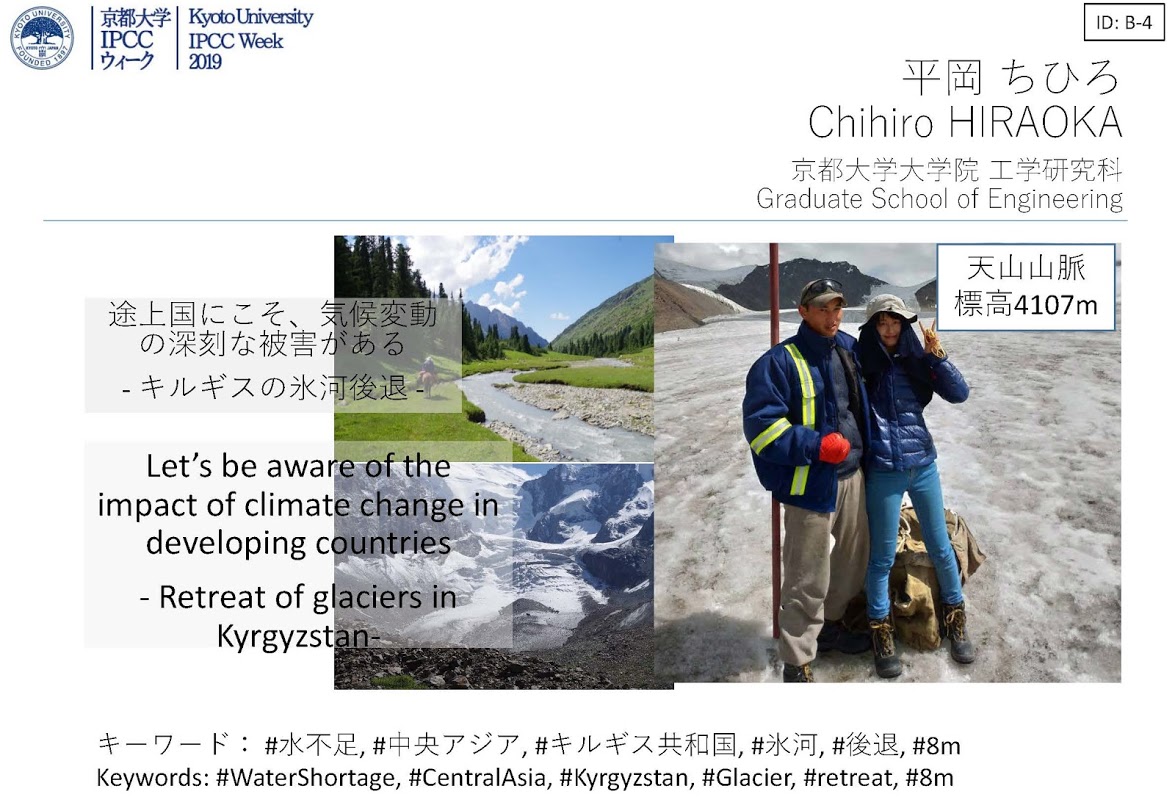
平岡 ちひろ 修士課程学生 (Ms Chihiro Hiraoka)
京都大学大学院工学研究科/防災研究所
・私は、水循環を再現するモデルを用いて、キルギス共和国における氷河の融解量解析を行っている。
・降水量の少ない中央アジアにとって氷河は非常に貴重な水源であり、水利用の大部分を氷河の融解水に依存している。
・雨が降らず、また降ってもすぐ蒸発する夏場でも人々が生活できるのは氷河の融け水のおかげ。中央アジアにとっての氷河は、京都市民にとっての琵琶湖疏水と似ていると感じる。
・地球温暖化の影響を受け、私が研究対象とする天山山脈の氷河は毎年8m後退している。
・中央アジアにおいて、水資源としてだけでなく美しい観光資源として機能してきた氷河は失われつつある。
・キルギス人は、自然と調和した伝統的な生活様式を守っており、彼らの生活様式は今日の地球温暖化の主原因ではない。
・地球温暖化に対して責任のない国の人々が、その被害を直に受けるという理不尽を私は取り払いたい。
・京都市民にあまりなじみのない途上国こそ、実は看過できない気候変動の問題が多くある.しかし途上国であるがゆえに解決の目途を時刻で立てられず,その現状を発信する力にも乏しい.先進国の人々に,発展途上国が気候変動で被っている理不尽な現状について知ってほしい。
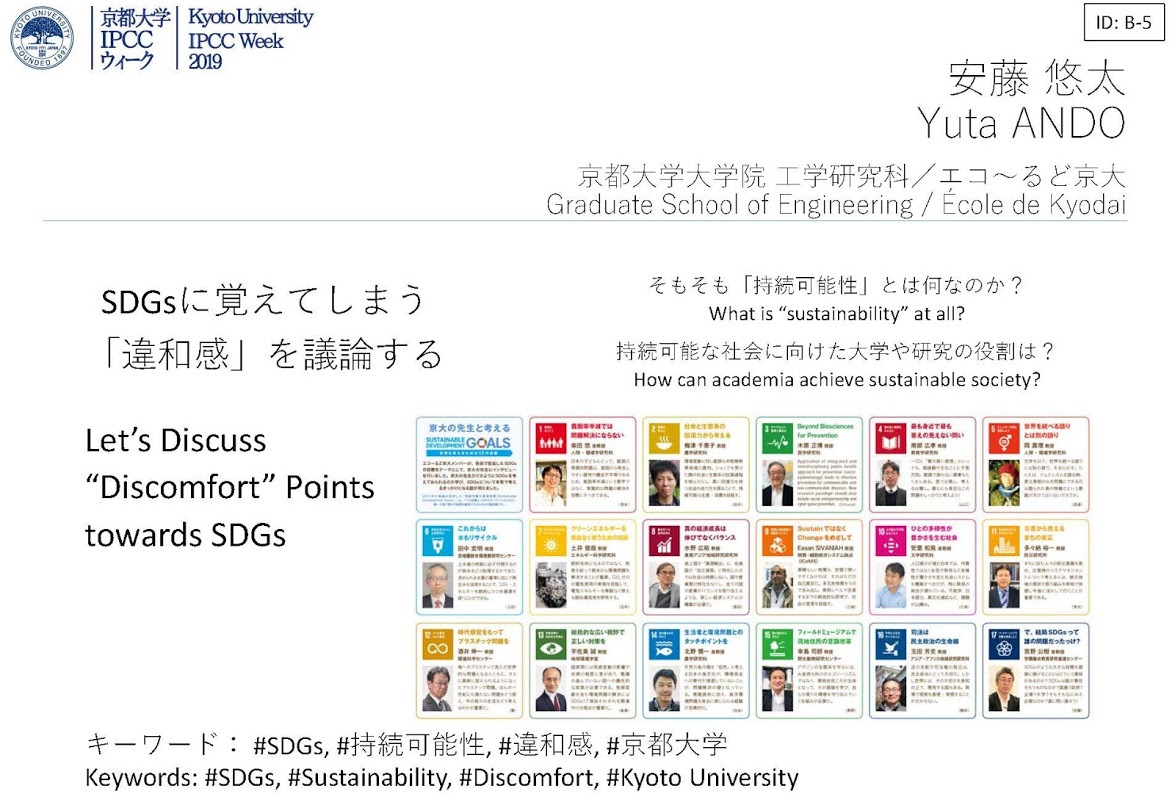
安藤悠太 博士課程学生 (Mr Yuta Ando)
京都大学大学院工学研究科/ エコ~るど京大
僕たちの世代にとって気候変動は、幼い頃から聞かされ続けてきたわかりやすくも重大な環境問題の一つである。昨今では、環境問題は数ある社会問題と複雑に結び付き、SDGsに代表されるように持続可能性という言葉をもって多くの人が注目し、それぞれが解決に向けて奔走している。僕も、学部生の頃から、京都大学における環境や持続可能性に関する取り組みに関わっている(エコ~るど京大:http://eco.kyoto-u.ac.jp/)。
大学の研究についても、持続可能性・SDGsの観点から評価されることが増えてきている。しかし、例えば、直接的な課題解決を目指しているわけではない基礎研究は、SDGsの文脈では価値付けできないのではないだろうか?僕自身は、工学研究科の博士後期課程として、幹細胞を用いたバイオエンジニアリングについて研究しているが、気候変動やエネルギーの分野とは離れたこの分野で持続可能性の話題を聞いたことは数えるほどしかない。このことから考えられるのは、持続可能性・SDGsの考え方はすべての分野にわたるように見えながらも、実は、大学の研究を評価したり分類したりする基準としては未成熟なのではないかということである。
現に、SDGsに対する「違和感」は京大の研究者の間にも散見されている。この「違和感」は、社会課題を17目標にラベリングしたSDGsが急速に注目を集め、人それぞれにSDGsの捉え方や解釈が異なっていることに起因しているような気がしている。それと同時に、SDGsというキーワードがある今、持続可能性に関する「違和感」の源をみんなで考えるのに絶好の機会が訪れている。そもそも持続可能性とは何なのだろうか?いつまで持続させたいのだろうか?今の社会を持続させることが本当に良いことなのだろうか?そのような問いを、京大の理念に書かれた「地球社会の調和ある共存に貢献するため」に照らして、持続可能性・SDGsについて深く議論してみたい。
若手研究者へFacebookで「いいね!」応援よろしくお願いします!
問い合わせ先/ Contact
[問い合わせ]ipcc@mail2.adm.kyoto-u.ac.jp
日本語:学術研究支援室(園部、仲野、神野)075-753-5179, 5740, 5737
English/ International Strategy Office (Sanoni, Adachi) 075-753-5044











